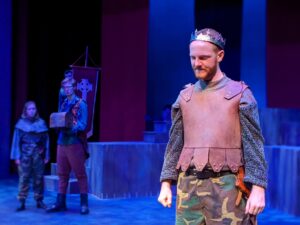The Tower Players took character development to a new level with nine different men and women playing the role of King Henry in the abridged and adapted version of “Henry V.”
The show will be performed in the Markel Auditorium between Nov. 10 and Nov. 13 at 7:30 p.m., and on Nov. 14 at 2 p.m. Tickets are free, but require reservation in order to attend.
“I think that it’s important to go into it and expect something different,” sophomore stage manager Brooklyn Little said. “This isn’t like run-of-the-mill Shakespeare. Matsos has this concept, and it’s definitely come to life. Don’t have any preconceived expectations in terms of what you remember about “Henry V,” because this is very different.”
The play follows the French and the English on the verge of war. What begins with a game of tennis balls devolves into the two nations going to war. The play ends with the union of the French and English via the marriage of Henry V and French princess Katherine.
“What we have now is a very condensed version of the story,” junior Matthew Welch said. “I’m not sure that it’s a slow burn as much as it is riding the line between comedy and tragedy. My first sequence is a good bit of just off-the-top, I’m-angry-at-you, and then I almost stab myself with a sword. Then, my second sequence is like ‘I’m leaving to go off to war, and I may never see my wife again.’ So it’s all throughout, and it’s gonna entirely depend on the scene.”
The switching of actors playing King Henry is symbolized by the transferring of a crown between actors with specific music and lighting to accompany the change.
“Once it gets to be too much, the crown is passed to a new actor,” Little said. “Basically, it shows the fact that Henry goes through so much development that from the beginning of the show to the end of the show, he’s a completely different person. Literally.”
The cast list itself came out without parts being delineated. Everyone was simply a part of “The Company.” Roles were changed and added throughout the rehearsal process.
“I wanted everybody to think of themselves as belonging to one unit, almost like a military unit that is responsible for the well being of the whole,” director Christopher Matsos said. “Every part knows the whole thing. I didn’t want them to go off thinking ‘okay, I get to just read this script now and only study my own lines.’ I wanted them to have a sense of the whole story.”
The cast is composed of students from a wide range of grades, from multiple freshmen to a fifth year senior, and, according to sophomore Liliana Cardwell, everyone is equally included in the process.
“There are no gaps in the cast,” Cardwell said. “We’re family, we are a team, and we work together. We have literally been in life threatening situations together. We’ve had to work to not destroy one another like 15 hours a week. It could be challenging, but we’ve got good people, so it hasn’t been.”
Most actors play more than one role, which necessitated creativity on the part of costume designer, Corinne Langford.
“Our costume designer is a genius,” Matsos said. “I mean, she’s so brilliant. She came up with designs that can represent multiple characters, and all the costumes look like they have the same DNA, which is the mark of a really good design.”
The first couple of weeks were blocking, before transitioning to 1-2 weeks of fight scenes, choreographed by Hillsdale alumna Caitlyn Grace ’12. Since then, rehearsals have been a combination of the two.
“It’s like learning a new language, and at the same time, you’re trying not to kill the person adjacent to you,” Cardwell said. “Then the adrenaline on stage kicks in, and you pray that it looks good. There is set choreography that you have to stick to while making it look like you’re just anticipating every move as if you have no idea what’s going on.”
On the technical side, the show features a simple set and limited props, aside from blunted medieval swords. Matsos says this is meant to encourage the audience to use their imagination in telling this story.
“Shakespeare was originally a highly accessible experience,” Matsos said. “A lot of people don’t know that and become pretty confused by the language. I’ve really reiterated to the cast: Imagine that you’re telling this story to children. Will they be able to follow this story? Are your character’s intentions clear enough? Shakespeare can be accessible and can be about action, as well as about rhetoric.”


